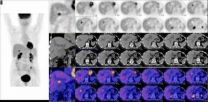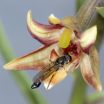(Press-News.org) Scientists at the University of Leeds have perfected a new technique that allows them to make molecular nanowires out of thin strips of ring-shaped molecules known as discotic liquid crystals (DLCs).
The findings could be an important step in the development of next generation electronic devices, such as light-harvesting cells and low-cost biosensors that could be used to test water quality in developing countries.
DLCs are disk-shaped molecules that are one of the more promising candidates for organic electronic devices. However, controlling their alignment has proved challenging to scientists and this has been a major barrier to their use in the liquid crystal display industry and as molecular wires.
"DLC molecules have a tendency to stack on top of each other like a pile of coins," said researcher Professor Stephen Evans from the University of Leeds. "But the difficulty comes in controlling the orientation of such columnar stacks with respect to the surface on which they lie. This is crucial for their future application.
"Traditionally, scientists have tried to get DLCs to align simply by rubbing the surface they sit on with a cloth to create micro grooves. This fairly primitive method works fine for macroscopic areas, but for new generations of devices we need to accurately control how liquid crystal arranges itself on the surface."
The Leeds team, led by Professor Richard Bushby and Professor Evans, has developed a completely novel technique using patterned surfaces to selectively control alignment, allowing them to stack the piles neatly to create molecular 'wires'.
The technique involves printing sheets of gold or silicon with self-assembled monolayers, which can be patterned with 'stripes' of high and low-energy. When a droplet of liquid crystal is applied to this patterned surface and heated, it spontaneously spreads out like liquid fingers over the high-energy stripes, leaving the low-energy regions bare.
Professor Evans said: "Within the stripes we found molecules arranged into hemi-cylindrical columns each several microns long, which we believe to be the highest level of control over DLC alignment to date. We also found that the narrower the stripes, the better the ordered the columns."
The team are hopeful that this level of control could lead to the development of a new type of biosensor, which could test for anything that alters the surface properties.
"By changing the surface properties we can get switch between alignments which is very interesting from the point of view or sensing devices," added Professor Evans. "Most biosensors require a backlight to see when a change has occurred, but it is very easy to see when a liquid crystal has changed direction – you just hold it up to the light.
"This opens up great possibilities for the production of very simple and, more importantly, cheap biosensors that could be widely used in the developing world."
The team are now testing the conductivity of these wires in the hope that they could be used for energy transfer in molecular systems. They are also looking at ways to polymerise the wires to make them stronger.
###
The project was funded by the Engineering and Physical Sciences Research Council (EPSRC) and the findings were recently published in the journal Advanced Functional Materials.
For more information
The paper, 'Planar Alignment of Columnar Discotic Liquid Crystals by Isotropic Phase Dewetting on Chemically Patterned Surfaces', is available online. http://onlinelibrary.wiley.com/doi/10.1002/adfm.200902140/abstract
Notes to editors
University of Leeds
The 2008 Research Assessment Exercise showed the University of Leeds to be the UK's eighth biggest research powerhouse. The university is one of the largest higher education institutions in the UK and a member of the Russell Group of research-intensive universities. The university's vision is to secure a place among the world's top 50 by 2015.
EPSRC
The Engineering and Physical Sciences Research Council (EPSRC) is the UK's main agency for funding research in engineering and the physical sciences. The EPSRC invests around £800 million a year in research and postgraduate training, to help the nation handle the next generation of technological change. The areas covered range from information technology to structural engineering, and mathematics to materials science. This research forms the basis for future economic development in the UK and improvements for everyone's health, lifestyle and culture. EPSRC also actively promotes public awareness of science and engineering. EPSRC works alongside other Research Councils with responsibility for other areas of research. The Research Councils work collectively on issues of common concern via Research Councils UK.
END
Disorganised and emotionally unstable, poorly adapted, suffering from alcohol problems, impulsive, or with a "globally adapted" personality. These are the features of the four diagnosed types of compulsive gamblers identified by researchers at the University Hospital of Bellvitge (IDIBELL) and the Autonomous University of Barcelona (UAB). According to the scientific team, only one of these four shows signs of a significant pathology.
"We need to use different treatments for each sub-group of pathological gamblers in order to respond to their specific therapeutic difficulties ...
BEER-SHEVA, ISRAEL, October 14, 2010 -- A new study by Ben-Gurion University of the Negev (BGU) researchers predicts that a new generation of malware (software written for malicious purposes like identity theft) could steal data on human behavior patterns, which is more dangerous than traditional, detectable attacks.
In the newly published paper, "Stealing Reality," Dr. Yaniv Altschuler and Dr. Yuval Elovici from BGU discuss malware threats that extract personal information about relationships in a real-world social network, as well as characteristic information about ...
Researchers a the University of Granada and the Department of Nuclear Medicine, Hospital Virgen de las Nieves at Granada found that the metabolic imaging diagnosis technique –based on the analysis of a structural analog of glucose labeled with a positron-emitting compound (18F)– allows early diagnosis of gall bladder cancer, a relatively rare disease with high mortality rates among most patients suffering from it.
For the purpose of this study, 62 patients were subjected to this scanning method, which represents the largest sample of patients with gall bladder cancer ...
In the first half of February 2009, two asteroids collided in a region of space beyond the orbit of Mars, as scientists from the Max Planck Institute for Solar System Research (MPS) in Germany have now discovered. The researchers were able to pinpoint the exact date of the impact more precisely than ever before. The debris of the crash had attracted the attention of scientists worldwide. Together with the largest earthbound telescopes and the Hubble Space Telescope, the OSIRIS camera system onboard ESA's space probe Rosetta, that was developed and is now operated under ...
VIDEO:
New research from the Bradley Hasbro Children's Research Center may help clinicians better predict how a child with obsessive compulsive disorder (OCD) will respond to some of the most commonly...
Click here for more information.
EAST PROVIDENCE, RI – New research from the Bradley Hasbro Children's Research Center may help clinicians better predict how a child with obsessive compulsive disorder (OCD) will respond to some of the most commonly used treatment approaches. ...
Scientists at the University of East Anglia have made an important breakthrough in the way anti-cancer drugs are tested.
A tumour cannot grow to a large size or spread until it has developed its own blood supply and leading research has looked for a way of halting capillary formation to stop tumours taking hold.
But new findings published today in the Journal of Cell Science have shown that scientists testing such treatments may not have been studying exactly what they thought they were.
The research proves that cells are able to switch their genetic profile – ...
Findings from a study, which appear in the Oct. 14, 2010 New England Journal of Medicine, helped influence the World Health Organization (WHO) to change its guidelines this year for the treatment of HIV-infected women who receive a single dose of the antiretroviral drug nevirapine to prevent HIV transmission to their babies. The study demonstrated that the single dose of nevirapine used to prevent mother-to-child transmission of HIV can hamper the drug's effectiveness if it is also used later as part of a regimen to treat these same individuals.
The Phase III study, called ...
CHAPEL HILL, NC – A collaboration between physicians and scientists at UNC Lineberger Comprehensive Cancer Center and the University of Texas M.D. Anderson Cancer Center has demonstrated that a biomarker called TCF21 may be used to develop a potential screening test for early-stage lung cancer.
Despite the fact that lung cancer is the leading cause of cancer deaths worldwide, early-stage lung cancer is difficult to diagnose. A number of proposed screening tests, including screening CT scans and serum markers, have not shown any benefit in enhancing patient survival.
TCF21 ...
Only one-fifth of primary care physicians in the US follow practice guidelines for colorectal cancer screening for all the tests they recommend, according to Dr. Robin Yabroff from the National Cancer Institute and her colleagues. About 40 percent followed guidelines for some of the tests they recommended and the remaining 40 percent did not follow guidelines for any of the screening tests they recommended. Furthermore, their analysis1 of physician screening recommendations for colorectal cancer shows that many clinicians either overuse or underuse screening. Their findings ...
Even Darwin was a self-admitted orchid lover. Dictionaries describe orchids as exotic ornamentals. Indeed, these plants – more than 30000 different species are thought to exist – are exotic due their extraordinary and diverse flower morphology. However, they are also exotic from a point of view other than beauty: as crafty imposters in order to achieve reproduction and to make sure that their ovaries are pollinated. Orchids depend on the assistance of pollinators, and like many other flowering plants, attract insects.
Epipactis veratrifolia, an orchid native in South ...





